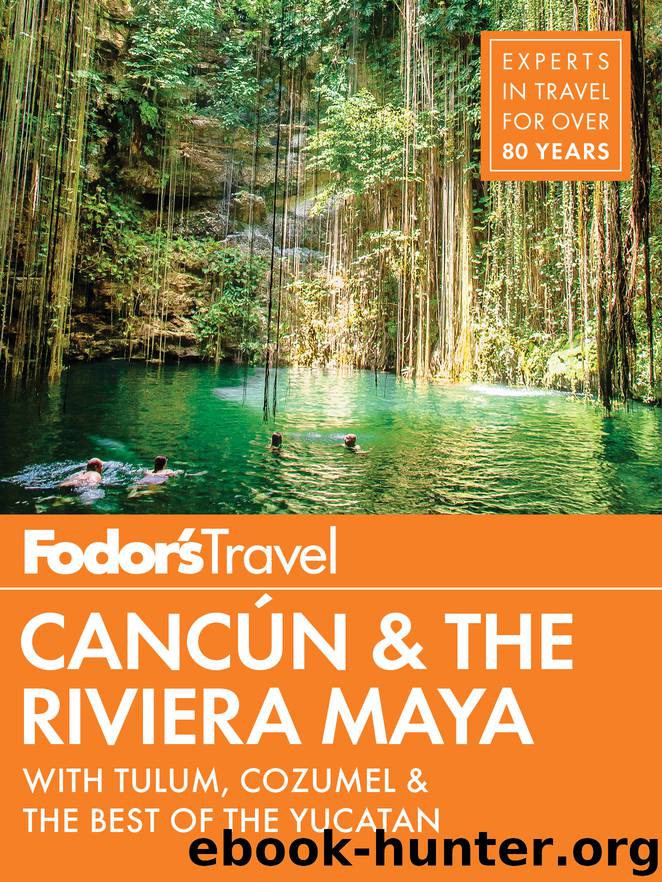Fodor's Cancun & the Riviera Maya by Fodor's Travel Guides

Author:Fodor's Travel Guides
Language: eng
Format: epub
Publisher: Fodor's Travel
Published: 2018-10-15T16:00:00+00:00
COBÁ
42 km (26 miles) northwest of Tulum.
Near five lakes and between coastal watchtowers and inland cities, Cobá (pronounced ko- bah) once exercised economic control over the region through a network of at least 16 sacbéob (white-stone roads)—one, measuring 100 km (62 miles), is the longest in the Mayan world. The city covered 70 square km (27 square miles), making it a noteworthy sister to Tikal in northern Guatemala, with which it had close cultural and commercial ties. Cobá is noted for its massive temple-pyramids, including the largest and highest one in northern Yucatán (it stands 138 feet tall). Although often overlooked by visitors who opt for better-known Tulum, Cobá is less crowded, giving you a chance to immerse yourself in ancient culture.
GETTING HERE AND AROUND
Cobá is a 35-minute drive northwest of Tulum, along a road that leads straight through the jungle. Taxis from Tulum cost about MX$338. ADO ( www.ado.com.mx) runs buses here from Playa del Carmen and Tulum at least three times a day: expect to pay about MX$95 between Cobá and Playa, MX$85 between Cobá and Tulum.
EXPLORING
Fodor’sChoice Cobá Ruins. Mayan for “water stirred by the wind,” Cobá flourished from AD 800 to 1100, with a population of as many as 55,000. Now it stands in solitude, and the jungle has overgrown many of its buildings—the silence is broken only by the occasional shriek of a spider monkey or the call of a bird. Most of the trails here are pleasantly shaded; processions of huge army ants cross the footpaths as the sun slips through openings between the tall hardwood trees, ferns, and giant palms. Cobá’s ruins are spread out and best explored on a bike, which you can rent for MX$40 a day. Taxi-bike tours are available for MX$120 for an hour and 20 minutes or MX$190 for two hours. If you plan on walking instead, expect to cover 5 to 6 km (3 to 4 miles).
The main groupings of ruins are separated by several miles of dense vegetation, but you can scale one of the pyramids to get a sense of the city’s immensity. TIP → Don’t be tempted by the narrow paths that lead into the jungle unless you have a qualified guide with you. It’s easy to get lost here, so stay on the main road, wear comfortable shoes, and bring insect repellent, sunscreen, and drinking water. Inside the site, there are no restrooms and only one small hut selling water (cash only).
The first major cluster of structures, to your right as you enter the ruins, is the Cobá Group, whose pyramids are around a sunken patio. At the near end of the group, facing a large plaza, is the 79-foot-high temple, which was dedicated to the rain god, Chaac. Some Maya still place offerings and light candles here in hopes of improving their harvests. Around the rear, to the left, is a restored ball court, where a sacred game was once played to petition the gods for rain, fertility, and other blessings.
Farther along the main path to your left is the Chumuc Mul Group, little of which has been excavated.
Download
This site does not store any files on its server. We only index and link to content provided by other sites. Please contact the content providers to delete copyright contents if any and email us, we'll remove relevant links or contents immediately.
In Too Deep (Coert Voorhees) by Coert Voorhees(1034)
Practice Makes Perfect by Gilda Nissenberg(1026)
Practice Makes Perfect: Complete Spanish Grammar, Premium Third Edition by Gilda Nissenberg(1019)
The Rough Guide to Belize by Rough Guides(1014)
Moon Guatemala (Moon Handbooks) by Argueta Al(1004)
Puerto Rico by Unknown(1002)
Insight Guides Central America by Insight Guides(1002)
The Rough Guide to Panama by Rough Guides(961)
México20 by Various(957)
Rough Guide to Belize by Rough Guides(937)
Lonely Planet Belize by Lonely Planet(924)
Honduras by Richard Arghiris(902)
Mexico: From the Olmecs to the Aztecs (Ancient Peoples and Places) by Michael D. Coe & Rex Koontz(899)
Moon Oaxaca by Bruce Whipperman(895)
Mexico by James Michener(878)
In Too Deep by Coert Voorhees(860)
Hartwood: Bright, Wild Flavors from the Edge of the Yucatán by Eric Werner & Mya Henry(849)
Insight Guides Guatemala, Belize and Yucatan by Insight Guides(811)
Mexico by James A. Michener(797)
